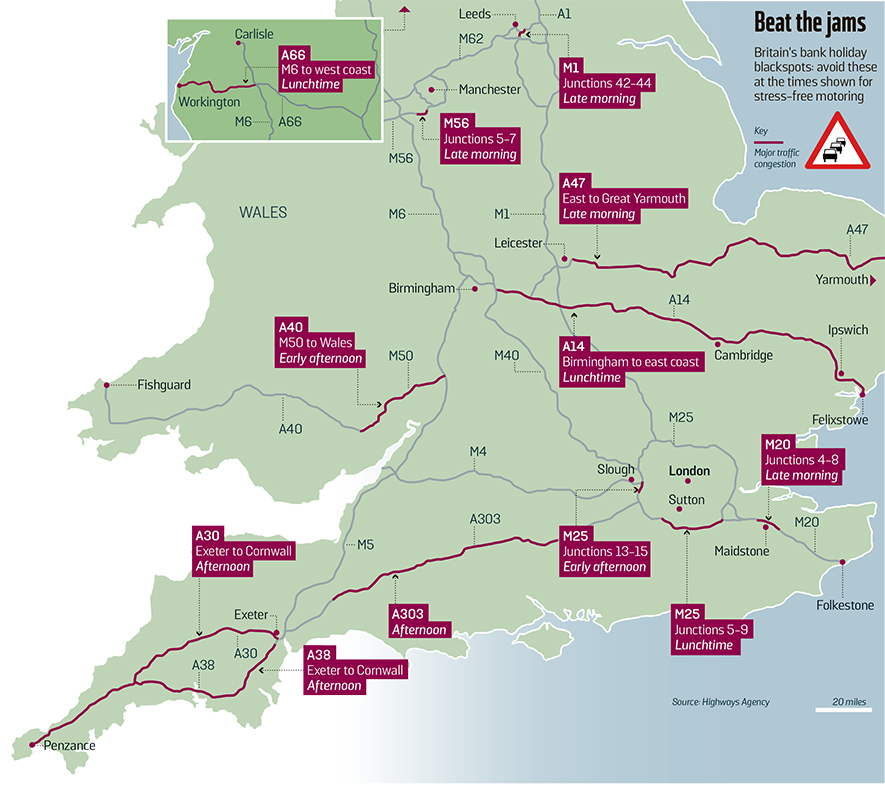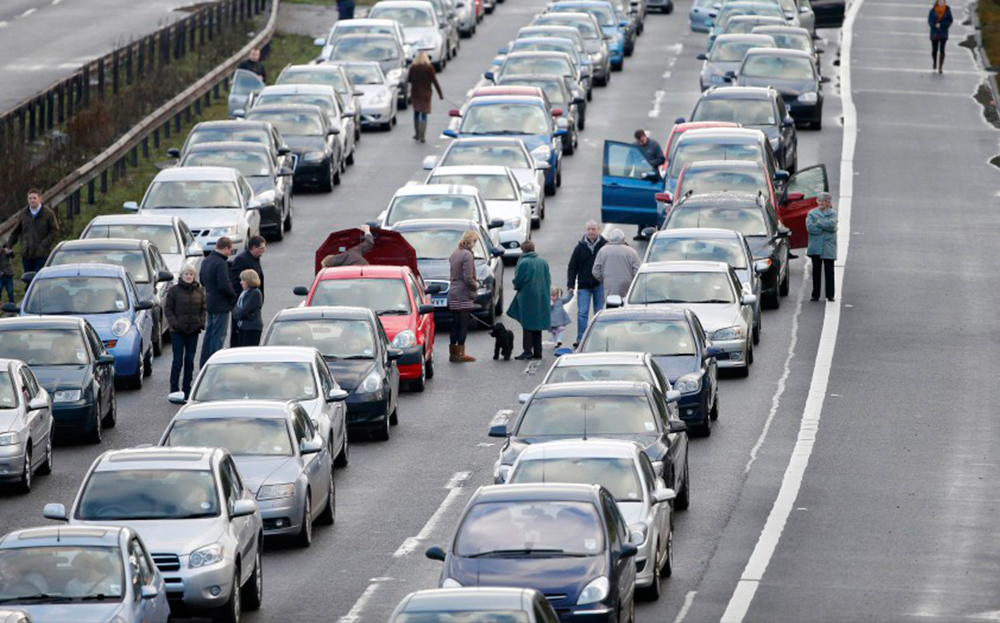How to beat the bank holiday traffic jams
Bank holiday traffic jams, you're toast

IT’S THE final bank holiday of the summer and millions of Britons are set to hit the road for one last grasp at fun.
Despite a mixed weather forecast, seaside resorts are expected to be full, music festivals have sold out, and scones have been baked for family visits. Which for drivers means jam all weekend — including on the journey back tomorrow afternoon, when the roads will be full of homebound families, including those who have jetted back from their annual holiday on Monday to max out their time away. In total, the AA predicts that 14m drivers will take to the roads this weekend.
“This is one of the busiest weekends of the year,” says Steve Crosthwaite, head of the Highways Agency’s national traffic operations centre, which oversees England’s motorway network and major A-roads. “We have a lot of bank holidays in the spring and summer, and this one is the last before Christmas, so people want to make the most of it.
“On key routes, you see 50% more traffic than on a normal day, and at those levels congestion starts to build up even if you don’t have any accidents.”
As well as the sheer number of cars on the road, Crosthwaite says that many jams are caused by motorists driving too closely together, creating an amplified effect when the car ahead brakes. A so-called shockwave of braking happens, with each car normally slowing down a little more than the previous one. This can bring traffic to a halt in a minute or two. Drivers weaving in and out of traffic can create the same problem.

Bank holiday drivers can also create difficulties. “People who drive less frequently can be intimidated by motorways,” says Crosthwaite. “You get people who drive in the middle lane because they think that it’s safer, even when there is free space
on the left-hand side. That causes congestion and frustration as cars squeeze past in a single lane.”
The Highways Agency has identified the 12 places that drivers will most want to avoid tomorrow, while road organisations have highlighted a further dozen. According to an AA-Populus survey, more than a third of people going away this weekend will head towards the seaside, meaning coastal routes will be some of the worst affected. Roads to and from Blackpool, Weymouth, Clacton-on-Sea and Southend-on-Sea are among those expected to be busiest tomorrow.
Although most roadworks on major routes have been removed for the weekend, Trafficmaster, which supplies traffic data to sat-nav companies, says that they remain on the M1 in Derbyshire and South Yorkshire between junctions 28 and 31, as well as on the M6 between junctions 10a and 14, where they are expected to cause severe delays.
If you’re reading this abroad and flying back to Gatwick, you should perhaps look away now. Big jams are expected on motorways close to the airport as holidaymakers return. Worst affected will be those who need to use the M25. Inrix, which also supplies traffic data for sat navs, predicts the entire western half of the motorway, from the M23 Gatwick junction 7 all the way round to junction 21, where the M1 leads north, will be crawling for much of the day.
The eastern half of the motorway will not offer travellers much relief either, with congestion predicted from junction 7 to the Dartford crossing bottleneck. Traffic will be heaviest around lunchtime.
However, Britain’s biggest traffic hotspot is unlikely to come as a surprise: southwest England is poorly served by motorways and, as a result, the A303 between London and Devon regularly resembles a fume-ridden car park, not least at one of its most picturesque points as it runs past Stonehenge, where it is only a single carriageway.
The Highways Agency warns that the road is expected to be busy eastbound all afternoon, and Inrix suggests that it may be quicker to take a long diversion away from Stonehenge instead, heading south to Salisbury and then back up to rejoin the road on the A338. This route normally takes 25 minutes longer than the A303 if both routes are clear but could shave hours off your journey if the main road is clogged.
So how else do you avoid the jams? According to Inrix, timing is everything: traffic is expected to build up from late morning tomorrow and peak at around 1pm, so unless you want to write off the day and head home early in the morning, the advice is to wait until later in the day when the hordes of overheating cars, exasperated drivers and bored passengers will have cleared to some extent.
You might also think carefully about using your sat nav. Figures from the Department for Transport suggest that about half of drivers will be relying on a navigation device to plot their route, with many using traffic information data that can spot the queues ahead and divert drivers around them.
In normal circumstances these systems, which gather data from a variety of sources, can work extremely well . But if the major alternative routes are busy too, you can still become stranded in traffic.
TomTom claims that its traffic service covers 99.9% of roads and that it will navigate rat runs as adeptly as a local, but other manufacturers are more wary of suggesting back roads— particularly after stories about lorries and caravans becoming trapped on unsuitable routes. Garmin says it aims to divert drivers onto major roads that are clearer than the standard route, although this may add to journey length. This is when it pays to pull out a trusty road atlas. With many sat navs deliberately blind to narrower B-roads (unless they are the only way to get to a destination), passengers can often successfully navigate a back route that avoids the clogged main roads — although any time savings can be wiped out if you’re stuck behind a tractor.
Watch out too for pockets of heavy congestion around bank holiday events. Trafficmaster warns of heavy traffic as people head home from the Reading and Leeds festivals tomorrow, while traffic from the Creamfields dance festival could result in queues around Warrington.

If you do find yourself stuck in a jam, there is at least hope on the horizon. Experts say that although jams will never be eliminated entirely, new technology is making inroads into the problem. Adaptive cruise control, which automatically adjusts a vehicle’s speed to maintain a safe distance from the car in front, is becoming more widespread, meaning drivers don’t bunch up so much and avoid the brake ripple effect.
Manufacturers are already showing off cars that communicate with one another — sending data in real time about accidents or other hazards ahead to prevent jams. They will also be able to communicate their alternative routes to avoid the other problem with existing technology: when one route is blocked, everyone else takes the same diversion.
Some experts even dream of the time when driverless cars mean accidents are virtually unheard of and a convoy of vehicles automatically keeps to a set speed, calculated by a central computer, making jams a thing of the past.
But where’s the fun in that?
Search for and buy used cars here




